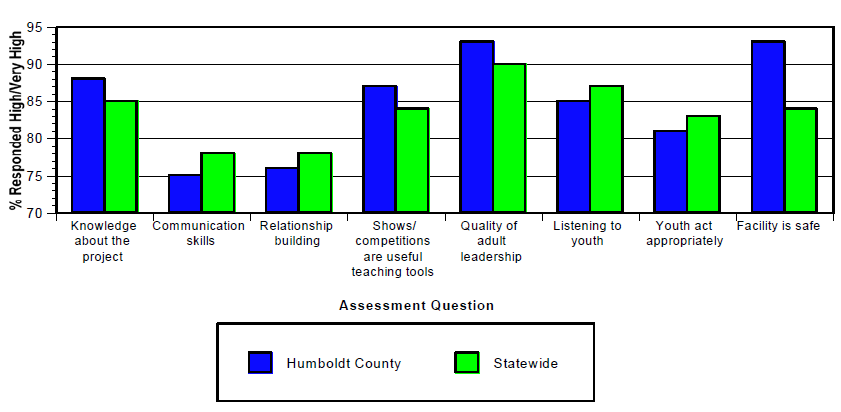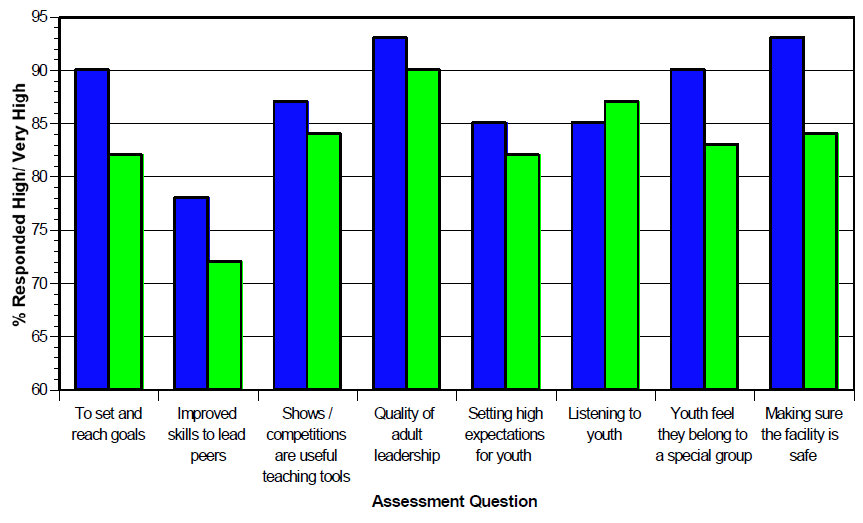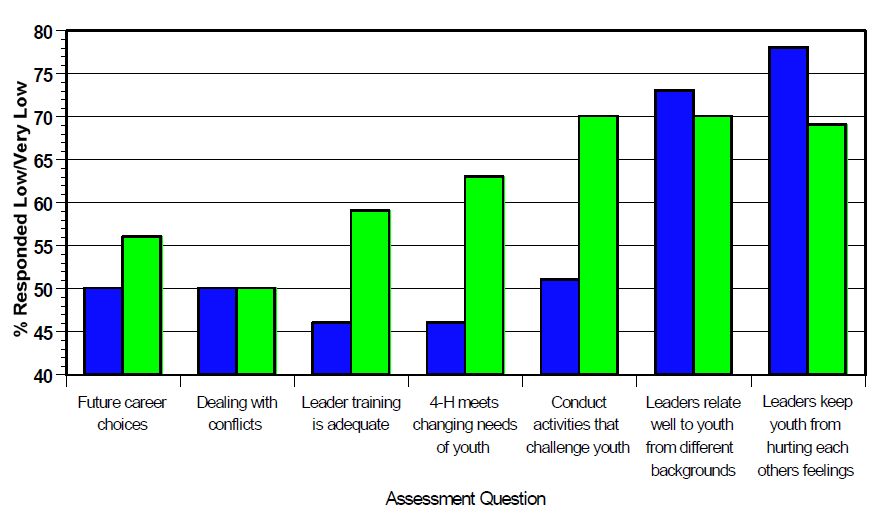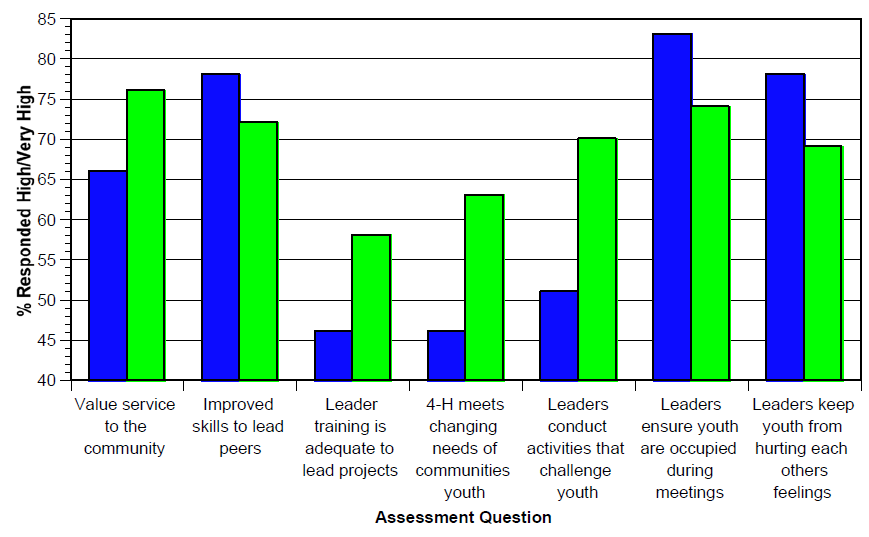Introduction
Humboldt County is located in north central Nevada, largely north of Interstate 80. The county covers 9,658 mi2, and the federal government administers about 81% of the land area. Winnemucca is the only incorporated city, but small outlying communities include Golconda, Paradise Valley, Orovada, McDermitt, Kings River, and Denio. Small acreage residential developments occur near Winnemucca in Grass Valley and Paradise Hill. The population peaked in 1998 at 17,075 and declined to 16,106 in 2000. Population has increased slightly in recent years. The population of the City of Winnemucca is about 7,000, with about 6,000 additional residents in Grass Valley and other small acreage (unincorporated) areas near Winnemucca. The remaining residents reside in or near the widespread ranching and farming communities. The local economy is heavily dependent on mining and agriculture.
The 4-H program in Humboldt County has both traditional agricultural programs and non-traditional programs directed more toward urban residents. The University of Nevada Cooperative Extension (UNCE) continues to seek improvement of the 4-H program. In 2003, UNCE mailed a program assessment survey to all 4-H parents and leaders in Nevada (Singletary and Smith, 2004). Understanding how 4-H may impact youth, leaders, and parents in each county is important because the UNCE manages 4-H programs at the county level. This fact sheet reports the results of the assessment survey for Humboldt County and compares Humboldt County’s results with the rest of Nevada. The purpose of this fact sheet is: 1) to inform 4-H parents, leaders and youth members about how 4-H impacts their lives, and 2) to provide 4-H professionals with information they can use to improve the 4-H program in Humboldt County.
Designing and Conducting the Assessment
UNCE used two models for youth development to design the assessment tool. The first model is based upon six desired outcomes from successful youth development (Blyth, 2000). These are confidence, competence, caring, connection, contributing, and character.
Successful youth development helps children become: confident they can make a difference; competent in their ability, skills, and knowledge; and able to work with others to develop and promote caring relationships. Confident and competent youth connect beneficially with people and organizations, contribute their services to make a difference in both their personal development and community, and demonstrate responsible and honest character, or a sense of who they are.
The second model used “core concepts” to provide a basis for successful youth development programs in Nevada (UNCE, 1993). These programs produce youth who:
- learn and practice self-responsibility and social responsibility to feel accountable and in control of their lives;
- recognize when and how to make informed decisions and implement decisions to solve a problem or achieve goals;
- communicate effectively in both verbal and written form, to share thoughts and feelings which increase social competence; and
- obtain career and occupational information to help prepare them for the workforce.
Questions developed for this assessment were based upon six desired outcomes of positive youth development and Nevada’s “core concepts” for teaching life skills. This resulted in a suite of questions in the following assessment areas:
- the effectiveness of 4-H in teaching youth about life skills
- the social skills youth learn
- the effectiveness of traditional 4-H teaching tools
- the efficacy of program management goals
- parent and volunteer leader skills to teach youth
- parent and leader management skills for 4-H programs
- prevent negative and high-risk behavior among 4- H youth
These questions were based on skills established by the National Committee on Community Programs to Promote Youth Development (Eccles and Gootman, 2002). Questions were designed to assess the indirect impacts of Nevada 4-H on both parents and volunteer leaders.
Survey recipients (n=3,074) included all parents and adult volunteer 4-H leaders of youth enrolled in the 4-H program, statewide, in 2003. These participants were selected because 4-H leaders and the parents of 4-H participants have the best opportunity to observe behavioral changes that occur among youth who participate in 4-H programs.
Each survey recipient received a two-page questionnaire with instructions, and a self-addressed, stamped return envelope. Also, they received a cover letter that explained the purpose of the survey, ensured confidentiality to participants, and thanked them for their participation. Of the 126 survey recipients in Humboldt County, 41 returned completed questionnaires (32% response rate).
Additional data collected on the assessment survey, or from other sources, included demographics about the 4-H program, and broader population, ethnic, and income demographics for Humboldt County and Nevada. Table 1 shows demographic data for Humboldt County.
Table 1. Demographic data from Humboldt County and Nevada
| Demographic |
Humboldt County |
Nevada |
| Number of school-age children |
3,504 |
365,994 |
| Number of 4-H youth in organized clubs |
172 |
15,288 |
Ethnic distribution of children (%):
White
Black
Hispanic
Native American
Asian |
68
<1.0
26
5
1 |
54
9
31
<1
5 |
Ethnic distribution of 4-H youth:
White
Black
Hispanic
Native American
Asian |
90
0
6
4
0 |
43
10
37
5
5 |
| Median family income ($) |
58,200 |
53,100 |
| Income distribution of 4-H families ($) |
10,000 to 149,999 |
<10,000 to >200,000 |
| Percent of families earning below $25,000 |
22 |
24.7 |
| Percent of persons living in poverty |
9.7 |
10.5 |
Statewide and County Impacts
On a scale of 1 to 5 with “1” being “very low” and “5” being “very high,” respondents circled the number that best indicated how effectively they thought the 4-H program was developing youth, and providing positive impacts for the adults involved. The numeric values (i.e., 1-5) were combined (collapsed) to obtain the percentage of respondents who rated an issue as high impact (i.e., a rating of 4 or 5) or low impact (i.e., a rating of 1 or 2). The results were tabulated to show the residents believe their facilities are safer than do statewide residents as a whole.
Figure 2 shows the highest rated assessment question, in each assessment category, for Humboldt County, with comparative results for statewide respondents. In Humboldt County, the top life skill youth learn is to reach and set goals. The highest rated social skill youth learn is improved skills to lead peers. In terms of 4-H teaching tools and program management goals, the highest rated impacts in Humboldt County are 4-H competitions and shows teach my child valuable skills and the quality of adult leadership, respectively. For 4-H parents and volunteer leaders, the highest rated parent and leader teaching skills are listening to youth and being easy to approach, and setting high expectations for 4-H youth. For program management, the highest rated leader skill is helping youth feel they are part of a special group. The highest rated prevention skill is making the 4-H facility safe.
The Humboldt County 4-H program appears to be doing well in two important areas of youth development: 1) teaching youth to set and reach goals and 2) improving skills to lead peers. At least 78% of respondents identified a high or very high impact in these two areas.
Figure 3 shows which assessment question, in each assessment category, in Humboldt County had the least impact (i.e., lowest response for high or very high impact). The lowest rated life skill learned by youth in Humboldt County is learning about future career choices. The lowest rated youth social skill is dealing with conflicts. In terms of 4-H teaching tools and program management goals, the lowest rated impacts in Humboldt County are volunteer leader training is adequate in providing the skills needed to lead a project and 4-H meets the changing needs of youth. For 4-H parents and volunteer leaders, the lowest rated impact for parent and leader teaching is conducting activities that challenge youth. The lowest rated skill for parent and leader management skills is relating well to youth from different cultures/ethnic backgrounds. The least rated impact from parent and leader prevention skills is keeping youth from hurting each others’ feelings.
Several impact areas in Humboldt County were between 10 and 19 percentage points lower than the state-wide responses. These included: 1) leader training is adequate; 2) 4-H meets the changing needs of youth; and 3) leaders conduct activities that challenge 4-H youth.
Figure 4 identifies the assessment question, in each assessment category, with the largest differential response between Humboldt County respondents and statewide respondents. Many of these differences were ten percentage points or more. Program areas that Humboldt County residents identified as having an impact much higher than statewide respondents included 1) improved skills for peer leadership; 2) leaders keeping youth occupied during meetings; and 3) leaders keeping youth from hurting one another’s feelings. Humboldt County respondents also identified numerous program areas where high impact was much less than in other parts of Nevada. These included 1) the value of service by 4-H participants to the community; 2) the adequacy of leader training; 3) 4-H is meeting the changing needs of youth, and 4) leaders conduct activities that challenge youth.
The significance of the absence of a challenge in much of the work conducted by 4-H youth is unclear. Many of the 4-H youth in Humboldt County are involved in animal projects that have daily tasks that are not particularly challenging. Their challenge, however, is doing all these tasks well enough, at the correct times to produce a successful project, often months later. The survey was not structured to address this level of complexity.
The low rating for leader training also is difficult to interpret without additional follow-up. Fewer than 50% of respondents identified leader training as adequate to lead projects, but over 90% rated the quality of adult leadership as high or very high (Figure 2). It appears respondents may have been addressing leader technical skills related to the project for the question in Figure 4, and the managerial skills of leaders to guide groups through a project, for the question in Figure 2. Given the broad range of projects implemented each year, and the limited staff at Extension offices in rural counties, UNCE cannot provide in-depth training on most technical skills, for most project leaders. A low rating for this assessment category is not unexpected. Volunteer leaders often volunteer for projects based on the desires of youth to learn specific topics, not the volunteers’ skill level in that topical area.
Figure 1. The assessment question from each assessment category, with the highest impact from statewide respondents. Comparative data from Humboldt County are presented. From left to right, each set of bars are the following assessment categories: youth life skills, youth social skills (columns 2 &3), teaching tools, parent and leader (P&L) program management, P&L teaching skills, P&L management skills, and P&L prevention skills. The legend in Figure 1 is applicable to Figures 2-4.

Data From Figure 1
Figure 2. The assessment question, in each assessment category, that received the highest impact rating by Humboldt County respondents, and its comparison with statewide respondents. From left to right, the assessment categories are youth life skills, youth social skills, teaching tools, parent and leader (P&L) program management, P&L teaching skills (columns 5 and 6), P&L management skills, and P&L prevention skills, respectively.

Data From Figure 2
Figure 3. The assessment question, in each assessment category, which Humboldt County respondents rated as having the least positive (i.e., high or very high) impact. Comparative statewide data are presented. From left to right each set of bars represent the following assessment categories: youth life skills, youth social skills, teaching tools, parent and leader (P&L) program management, P&L program management, P&L teaching skills, P&L management skills, and P&L prevention skills.

Data From Figure 3
Figure 4. The assessment question, from each assessment category, with the largest difference between respondents from Humboldt County and statewide participants. From left to right, each set of bars represents the following assessment categories: youth life skills, youth social skills, teaching tools, parent and leader (P&L) program management, P&L teaching skills, P&L management skills, and P&L prevention skills.

Data From Figure 4
Developing an Action Plan to Strengthen Humboldt County 4-H
The results of the assessment survey indicate five areas where the Humboldt County program may need additional emphasis. These include 1) providing information about future career options; 2) learning to deal with conflict among youth; 3) improving leader training; 4) developing programs that meet the changing needs of youth; and 5) leaders conducting activities that challenge youth.
With respect to providing information about future career options, Cooperative Extension in Humboldt County can provide on-line access to youth to research career options on the Internet. Also, staff is available for discussion of these topics and could direct youth to individuals they know in different disciplines, and these individuals could provide feedback.
Cooperative Extension will conduct research to determine the availability of materials related to conflict resolution, and obtain suitable material for use by volunteer leaders and youth. Humboldt County Extension staff recognizes the need for its staff, volunteers and youth to receive awareness training and materials about respecting others’ feelings. Awareness training would go a long way towards resolving many conflicts.
Extension staff requires additional input from volunteer leaders, parents, and perhaps youth to clearly identify what aspects of leader training may need to be improved, which types of programs need to be developed to meet the changing needs of youth, and the type of challenging activities that can be developed for youth. The Humboldt County Extension staff will explore the possibility of conducting focus group meetings or open houses in the fall/winter of 2005 to obtain specific input from 4-H participants.
References
- Blyth, D. 2000. “Extension’s Roles in Community Youth Development for the 21st Century,” The Center. Communication and Educational Technology Services, University of Minnesota Extension Service.
- Eccles, J. and J. Appleton Gootman. 2002. Committee on Community-Level Programs for Youth. Community Programs to Promote Youth Development. Washington, DC: National Academy Press.
- Singletary, L. and M. Smith. 2004. Nevada 4-H Statewide Impact Assessment. Extension Bulletin. EB-04-01. Reno, NV: University of Nevada Cooperative Extension.
- University of Nevada Cooperative Extension. 1993. “Youth Development in Nevada, Core Concepts: A Framework for Programming.” Tri-fold Brochure.
Data From Figure 1
| Assessment Question |
Humboldt County % Responded High/Very High |
Statewide % Responded High/Very High |
| Knowledge about the project |
88% |
85% |
| Communication skills |
75% |
78% |
| Relationship building |
76% |
76% |
| Shows/competitions are useful teaching tools |
87% |
84% |
| Quality of adult leadership |
93% |
90% |
| Listening to youth |
85% |
87% |
| Youth act appropriately |
81% |
83% |
| Facility is safe |
93% |
84% |
Data From Figure 2
| Assessment Question |
Humboldt County % Responded High/Very High |
Statewide % Responded High/Very High |
| To set and reach goals |
90% |
82% |
| Improved skills to lead peers |
88% |
72% |
| Shows/competitions are useful teaching tools |
87% |
84% |
| Quality of adult leadership |
93% |
90% |
| Setting high expectations for youth |
85% |
82% |
| Listening to youth |
85% |
87% |
| Youth feel they belong to a special group |
90% |
83% |
| Making sure the facility is safe |
93% |
84% |
Data From Figure 3
| Assessment Question |
Humboldt County % Responded Low/Very Low |
Statewide % Responded Low/Very Low |
| Future career choices |
50% |
56% |
| Dealing with conflicts |
50% |
50% |
| Leader training is adequate |
46% |
59% |
| 4-H meets changing needs of youth |
46% |
63% |
| Conduct activities that challenge youth |
51% |
70% |
| Leaders relate well to youth from different backgrounds |
73% |
50% |
| Leaders keep youth from hurting each others feelings |
77% |
69% |
Data From Figure 4
| Assessment Question |
Humboldt County % Responded High/Very High |
statewide % Responded High/Very High |
| Value service to the community |
66% |
76% |
| Improved skills to lead peers |
78% |
72% |
| Leader training is adequate to lead projects |
46% |
57% |
| 4-H meets changing needs of communities youth |
46% |
63% |
| Leaders conduct activities that challenge youth |
51% |
70% |
| Leaders ensure youth are occupied during meetings |
83% |
74% |
| Leaders keep youth from hurting each others feelings |
77% |
69% |


